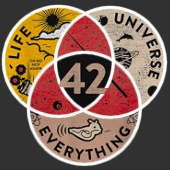Have you ever had a secret you wanted to hide in plain sight while still feeling secure? If so PGIE is just the program for you!
Well my nephew has come up with one and I think it's worth sharing. The image shows the picture I encoded of a Blue Tit, and next to it is the encrypted file after it had been encrypted with the programme. Mess with one pixel or any other attribute of the key-file or the decrypted image and it is unrecoverable.
PGIE uses an innovative and unique mix of new and traditional encryption techniques to store data within a randomly generated pixel image that can only be decoded using a special key file.
How It Works: (for the geeky among you)
PGIE first encrypts the data using a Rijndael symmetric algorithm. The key used to encrypt the data is a randomly generated 256 bit binary key that is unique to each encode.
The encrypted data is then split into sections and stored within the image. The data is then further secured by modifying the file based on the information stored within the key file. Finally the image is modified to make the original entry point unreadable.
If either the key file or encoded images are modified or damaged then the encryption is one way.
In order for a brute force attack to be successful on this encryption the whole key file image would have to be guessed precisely; every red, green, blue and alpha component would have to match the original in order for the decryption to occur successfully. This would take a very, very long time to achieve with modern computers. See the technical details section below.
Technical Data:
There are a set of 65,535 possible characters that can be used in the encryption key and the key is 256 characters in length. This means that there are 65,535^256 possible key sets to choose from - one very large number! In the simplest terms possible - if a computer can generate a billion keys per second then it would take far, far longer than the universe has existed to forcibly break.
There are four channels for data within a PNG pixel, red, green, blue and alpha. Each of these can range in value from 0-255. That means that there are 256^4 possible colour values per pixel (4,294,967,296). As the image size grows more pixels need to be correctly guessed in order to decode the image. As such each added pixel makes the image more difficult to decode again, making it virtually impossible to forcibly break.
This is the Chromo text encryption we use for really sensitive stuff, for everything else we use the other type as in the reply, we are safe from our government. It;s saved as a file, sent in an email, decrypted with a personal key. He's even made it open by default with a double-click so there's less steps to take.
I am proud of him so please forgive my enthusiasm.
My nephews new encryption standard
A free app he's designed for anyone interested
6 posts • Page 1 of 1
My nephews new encryption standard
- Attachments
-
 PGIE Encrypt.rar
PGIE Encrypt.rar- (325.5 KiB) Downloaded 244 times
-

Fejinwales
- Awards: 1
- Posts: 228
- Topics: 33
- CoverArt: 523
- Resources: 16
- Joined: May 25, 2009
- Location: Tynewydd, South Wales. UK
- Thanks: 1
- Thanked: 429 times in 256 posts
Re: My nephews new encryption standard
Pretty cool. Is anyone using this?
-

VincentLupo
- Posts: 5648
- Topics: 115
- CoverArt: 199
- Joined: March 19, 2009
- Thanks: 6349
- Thanked: 122 times in 69 posts
Re: My nephews new encryption standard
I have not but I have seen this type of encryption. .gif)
.gif)
-

ctaulbee
- Awards: 7
- Posts: 3719
- Topics: 293
- CoverArt: 6
- Resources: 484
- Joined: March 19, 2011
- Occupation: The Devil's Hand
- Location: Realm of Nightmares
- Thanks: 5391
- Thanked: 1147 times in 531 posts
Re: My nephews new encryption standard
Hi guys, I don't know when you commented here - for some reason I no longer get email notifications from Uncovered.
Well I use it to send pictures and files to all my friends now (though we don't do it often), especially since we are now legally being spied on by all networks through text, email, phones, everything, at the behest of our wonderful government. The best one though is the new one he crated for sending text through email or anything else from a PC. It's even more complicated than this but so simple to use, he's an IQ of 186 and he reckons it is unbreakable. My friends and I send all normal text emails to and from each other with the new programme he's developed, but they have been told not to give the software out to anyone else as it won't work in just anyone's computer. He;s cleverly taken a leaf out of Microsoft's book. He needs some information about the computer the programme is going to be installed in. He asks we install speccy, send him the text file of the hardware section, then he uses some of that information and enters it Into the code and then recompiles it and protects it with the same encryption. The result is that that particular .exe will only run on that computer.
Itcan encrypt (and decrypt) in two ways.
Here's an example of the plain encryption: The sentence I'm using is:
"Windows XP was stopped being supported by Microsoft over two years ago, this meant that they would no longer bother making updates, releasing fixes or in any way offering support to its users".
This is the text produced for sending:
üɯɈĎᔬᕚᔡᑄᐳᕗᒋᒠᕰɇᓓᐙϦᗗϖᗰᕄЉᚗᓻᖋᕋɝǵᚲǪᔵŒᗼᓵᓃᔸτᒋϛΰŒᓓᘆᚰᗄᚖϪᔵᛉǔРᐮᘒᓜϒᗛŶϨᚰᐕᔉᓧᚥǙϊДᕰᓠᓻᑄᘿûᗥᘘᕙᖱ
ũƼēЇᕗᙱЗǫɇŗεᑄᗖώϊĂϨᑢᙵᖋАᕽᐬᗓᑕᔨϻᗠᖋᓊᕕûϪᐣᒬϋᛁᖧDZϡϖᗥᒹɐᐯᗱᐮȍŰčƇᗗȵᕧЭᚺϺᒡᗉОŐᘲᐥϾşᚶĀûᒜċᘅôᗫѕА
ᔸĔᔃĐᑈȬȟᙥɋᘿǙłᓌᗖᔏᚂᑯᕯϙᘰᕣᒹᕰǮᒗᘆφǦĻᛵᚽᓑᕧᕳᛱᔮᒩřᙎϹᛉᚏᓻᒀdzЇĦᕢᒟϨɇLJĺᒲᘁᕇȑКᑿǮᕳŇᒲŦᕮ϶ЗᐿᓠɿᒀᕟᒏŁᒾ
ᒟᘌϏУᗗŎᔖĘᛶǫᘩᗫᑯϜᗗüėᓏᗖᚰLJᖘКᙒϚᗰᒱᑈŒϾŇᒺᑅᗉᖊϱĎνᙽɤȸᐷᖠŧᓚϤŵᗇᘺᗥᘭᕖᛣȾᐭᘺᓱᚠϫᚢᐭᗹᗤᕧᚂᖐᒲɝᕮᙩᒱᘴᗼᓸ
ᔡᒲĒᒢėέᘲȬᘯȁœᒏᗴᙩǶᕙᑨᓻᖧœᗄЂДᕅᑻᐯςᔸȍЄᓏᚴДЉǒĤᙝĔϋûᗰέᗶᒫᑢᖋřěϒГᒩȵôϺşᗡᒡčᓬᗜĖôɺᓓϪᒰûŗᔵğᚗļᕤűᙒ
ᗔОᑬᘴᗂĤᓽᛱᒩᖷİᚵᕙᑨǝᙣᚮᓟᒲᕣᘩЇᖸϺᒀᘌᘹĦᔲᒹᒬᕧɺɤϮνᕮᙩᕴᑿᚗᑛᐙᗏŎᗴᓎᚽᒬᚰLJᖐᕟɝĦᒜĐϔϏᔟιЏᒡčᕣēϬϏŗƦᓧᐲᑭᚲᗫ
ϐȬǁᚘᕋᒡϒᖊДϤϛᘘᔡᚮᘿɓϠɈɐŤᒗνᛏᗇᗔɏᑬᒬᒓᘦᖋᓿᗄᐶᒜύčᕧᓓᛱАᗇřİĐǭᒤLJᐮᓧЉᐭᗔᒩЊᕐϺᔈᙥᗖǵϊǰᐾᐯςιᘒᕽᐭᔃϛᔵᖱᗰ
ᘎᗐᑶᒫᗔᕅᑱᚰɺᘆᗏνᐶİĥᗛĴᛣѕᙈᒹᖷᔃϱᚪŤᗜᑮᒅᒡ
It is created and decrypted by the programme. But should I require an even greater security I can create a file based on colours and send that. It needs a key that I create to decrypt it (all my friends have mine and I have theirs). It is a bit more complicated but way, way more encrypted.
I've added an example of this Chromo type of encryption using the same text using this form of encryption to the original post as I cannot add a picture to the reply.
I am very proud of him so please forgive my enthusiasm.
I would be happy to let my nephew know what you think as it was for that reason he asked me to put up the original post.
Well I use it to send pictures and files to all my friends now (though we don't do it often), especially since we are now legally being spied on by all networks through text, email, phones, everything, at the behest of our wonderful government. The best one though is the new one he crated for sending text through email or anything else from a PC. It's even more complicated than this but so simple to use, he's an IQ of 186 and he reckons it is unbreakable. My friends and I send all normal text emails to and from each other with the new programme he's developed, but they have been told not to give the software out to anyone else as it won't work in just anyone's computer. He;s cleverly taken a leaf out of Microsoft's book. He needs some information about the computer the programme is going to be installed in. He asks we install speccy, send him the text file of the hardware section, then he uses some of that information and enters it Into the code and then recompiles it and protects it with the same encryption. The result is that that particular .exe will only run on that computer.
Itcan encrypt (and decrypt) in two ways.
Here's an example of the plain encryption: The sentence I'm using is:
"Windows XP was stopped being supported by Microsoft over two years ago, this meant that they would no longer bother making updates, releasing fixes or in any way offering support to its users".
This is the text produced for sending:
üɯɈĎᔬᕚᔡᑄᐳᕗᒋᒠᕰɇᓓᐙϦᗗϖᗰᕄЉᚗᓻᖋᕋɝǵᚲǪᔵŒᗼᓵᓃᔸτᒋϛΰŒᓓᘆᚰᗄᚖϪᔵᛉǔРᐮᘒᓜϒᗛŶϨᚰᐕᔉᓧᚥǙϊДᕰᓠᓻᑄᘿûᗥᘘᕙᖱ
ũƼēЇᕗᙱЗǫɇŗεᑄᗖώϊĂϨᑢᙵᖋАᕽᐬᗓᑕᔨϻᗠᖋᓊᕕûϪᐣᒬϋᛁᖧDZϡϖᗥᒹɐᐯᗱᐮȍŰčƇᗗȵᕧЭᚺϺᒡᗉОŐᘲᐥϾşᚶĀûᒜċᘅôᗫѕА
ᔸĔᔃĐᑈȬȟᙥɋᘿǙłᓌᗖᔏᚂᑯᕯϙᘰᕣᒹᕰǮᒗᘆφǦĻᛵᚽᓑᕧᕳᛱᔮᒩřᙎϹᛉᚏᓻᒀdzЇĦᕢᒟϨɇLJĺᒲᘁᕇȑКᑿǮᕳŇᒲŦᕮ϶ЗᐿᓠɿᒀᕟᒏŁᒾ
ᒟᘌϏУᗗŎᔖĘᛶǫᘩᗫᑯϜᗗüėᓏᗖᚰLJᖘКᙒϚᗰᒱᑈŒϾŇᒺᑅᗉᖊϱĎνᙽɤȸᐷᖠŧᓚϤŵᗇᘺᗥᘭᕖᛣȾᐭᘺᓱᚠϫᚢᐭᗹᗤᕧᚂᖐᒲɝᕮᙩᒱᘴᗼᓸ
ᔡᒲĒᒢėέᘲȬᘯȁœᒏᗴᙩǶᕙᑨᓻᖧœᗄЂДᕅᑻᐯςᔸȍЄᓏᚴДЉǒĤᙝĔϋûᗰέᗶᒫᑢᖋřěϒГᒩȵôϺşᗡᒡčᓬᗜĖôɺᓓϪᒰûŗᔵğᚗļᕤűᙒ
ᗔОᑬᘴᗂĤᓽᛱᒩᖷİᚵᕙᑨǝᙣᚮᓟᒲᕣᘩЇᖸϺᒀᘌᘹĦᔲᒹᒬᕧɺɤϮνᕮᙩᕴᑿᚗᑛᐙᗏŎᗴᓎᚽᒬᚰLJᖐᕟɝĦᒜĐϔϏᔟιЏᒡčᕣēϬϏŗƦᓧᐲᑭᚲᗫ
ϐȬǁᚘᕋᒡϒᖊДϤϛᘘᔡᚮᘿɓϠɈɐŤᒗνᛏᗇᗔɏᑬᒬᒓᘦᖋᓿᗄᐶᒜύčᕧᓓᛱАᗇřİĐǭᒤLJᐮᓧЉᐭᗔᒩЊᕐϺᔈᙥᗖǵϊǰᐾᐯςιᘒᕽᐭᔃϛᔵᖱᗰ
ᘎᗐᑶᒫᗔᕅᑱᚰɺᘆᗏνᐶİĥᗛĴᛣѕᙈᒹᖷᔃϱᚪŤᗜᑮᒅᒡ
It is created and decrypted by the programme. But should I require an even greater security I can create a file based on colours and send that. It needs a key that I create to decrypt it (all my friends have mine and I have theirs). It is a bit more complicated but way, way more encrypted.
I've added an example of this Chromo type of encryption using the same text using this form of encryption to the original post as I cannot add a picture to the reply.
I am very proud of him so please forgive my enthusiasm.
I would be happy to let my nephew know what you think as it was for that reason he asked me to put up the original post.
-

Fejinwales
- Awards: 1
- Posts: 228
- Topics: 33
- CoverArt: 523
- Resources: 16
- Joined: May 25, 2009
- Location: Tynewydd, South Wales. UK
- Thanks: 1
- Thanked: 429 times in 256 posts
Re: My nephews new encryption standard
Hi Jeff I just sent you an email let me know when you get it
or if that fails
when you notice this post and there is no email from me, then let me know that too.gif)
or if that fails
when you notice this post and there is no email from me, then let me know that too
.gif)
-

ctaulbee
- Awards: 7
- Posts: 3719
- Topics: 293
- CoverArt: 6
- Resources: 484
- Joined: March 19, 2011
- Occupation: The Devil's Hand
- Location: Realm of Nightmares
- Thanks: 5391
- Thanked: 1147 times in 531 posts
Re: My nephews new encryption standard
That's cool Jeff.
-

VincentLupo
- Posts: 5648
- Topics: 115
- CoverArt: 199
- Joined: March 19, 2009
- Thanks: 6349
- Thanked: 122 times in 69 posts
6 posts • Page 1 of 1
Similar topics
Topic Title |
Views |
Replies |
Topic Author |
Forum Section |
|---|---|---|---|---|
| New Member | 72 | 6 | SirUlrich | Introductions |
| New Member | 130 | 6 | virgilhiltz1963 | Introductions |
| New to the site | 1296 | 6 | Prtrbrts0303 | Introductions |
| New member! | 849 | 6 | NobRai | Introductions |
| New guy! | 1002 | 6 | lukasskott | Introductions |
Who is online
Users browsing this forum: No registered users and 186 guests










